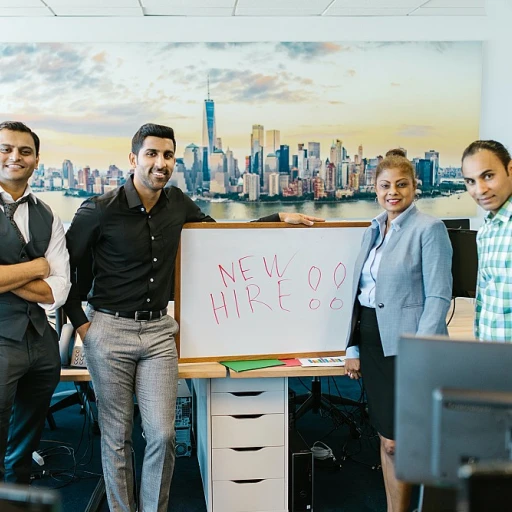The Forming Phase: Building Foundations
Creating a Collaborative Environment from Day One
In the journey of team development, the initial phase known as forming lays the groundwork for future success. This stage is crucial as team members come together for the first time, each bringing their own individual skills, perspectives, and expectations. It is during this period that foundational relationships are established, setting the tone for future interactions and collaboration.
The forming stage is characterized by team members getting acquainted with each other, understanding their roles and responsibilities, and beginning to outline shared goals. At this point, team leaders play a pivotal role in facilitating introductions, clarifying the project objectives, and ensuring that the team's expectations align closely with the organizational vision. Leadership here is not just about giving direction but also about creating an environment where every member feels valued and engaged.
During forming, it is vital for leaders to encourage open communication, where team members can freely express their ideas, concerns, and suggestions. This openness lays a solid foundation for future stages, like storming and norming, where conflicts and challenges will inevitably arise. Fully understanding these early dynamics can immensely aid in the later stages of group development, smoothing the transition into subsequent phases.
Introducing structured activities or workshops can be an effective strategy to ease the team into a rhythm of cooperation and mutual understanding. This initial collaboration helps in building trust, a key component in reaching the high efficiency that typifies the performing stage. A well-facilitated forming phase ensures that team members are prepared to navigate the storming challenges ahead and move towards achieving optimal productivity.
For more insights on how to navigate these initial stages effectively, exploring methodologies could prove highly beneficial.
Storming: Navigating Conflicts and Challenges
Addressing Team Conflicts and Overcoming Challenges
The "storming" phase is an instrumental period in team development where conflicts and challenges are common, but also necessary for the team's evolution. During this stage, team members may face disputes in areas such as roles, responsibilities, and differing viewpoints. This is where the dynamics of forming storming become essential in shaping how teams function in high-pressure environments. Understanding that the storming stage is a natural part of the process can help guide teams through this sometimes tumultuous period. Recognizing the roles of team leaders and emphasizing clear communication is vital for resolving conflicts. Strong leadership that fosters open dialogue is key in moving past this stage, allowing team members to articulate their goals and address conflicts constructively. In addition, establishing defined processes that accommodate diverse perspectives can prevent clashes from derailing project goals. Leaders should champion mechanisms for conflict resolution which are crucial for transitioning to the norming stage, where the team starts to gel. Emphasizing the benefits of healthy conflict builds a solid foundation for group development. Team members should appreciate the value of diverse opinions, as these differences can spur innovation and drive progress within the group. Ultimately, navigating the storming stage effectively is essential for the team to progress to later stages, where greater cohesion and efficiency in the performing stage are achieved. Teams that pass through this storming phase with a better understanding of their dynamics are well-prepared for the subsequent stages of development. For further insights on managing the challenges of this complex stage, refer to resources on Understanding the Stages of Team Development.Norming: Establishing Team Cohesion
Cultivating Team Synergy
In the Tuckman model of team development, the transition from storming to norming represents a crucial stage. This phase marks a period when teams begin to establish cohesion, laying the groundwork for effective collaboration and productivity. Here, the group starts defining roles and responsibilities more clearly, paving the way for high efficiency as they progress towards the performing stage.
During this norming process, team members start building trust and developing stronger relationships. This evolution is significant because it fosters a supportive environment where individuals feel comfortable expressing ideas and providing constructive feedback. It's in this atmosphere of growing mutual respect that members feel confident in their roles, enabling smoother project execution.
Team leaders play an essential part in guiding this transition. Through skillful leadership, they can help reinforce collective goals and align the team's focus. Effective leaders recognize the importance of maintaining open channels of communication, encouraging team members to voice concerns or suggest improvements without fear of conflict.
- Communication: Open dialogue helps to address lingering challenges from the storming stage, ensuring the team is aligned and prepared to meet objectives.
- Support: By providing resources and encouragement, leaders can bolster team confidence, aiding the establishment of a cohesive and productive group dynamic.
- Respect: Encouraging mutual respect among members enhances the group's willingness to collaborate and innovate.
As the team progresses, the alignment achieved in norming sets the stage for entering the performing stage. This level of cohesion is not only pivotal for accomplishing tasks but also instrumental in enhancing employee engagement. When teams seamlessly transform challenges into opportunities, they become more adept at achieving their collective goals.
To explore further insights into how training and development can enhance team engagement, visit convergence training strategies.
Performing: Achieving High Efficiency
Maximizing Team Efficiency and Collaboration
In the process of group development, teams eventually progress to a stage where efficiency and collaboration reach their peak. This is known as the performing stage. At this juncture, teams have likely navigated through the earlier forming stage of establishing foundations and relationships, contended with the storming stage's challenges and conflicts, and established team cohesion during the norming phase. During the performing stage, the primary focus shifts toward high efficiency and achieving goals. Team members are now comfortable in their roles and responsibilities, having developed a mutual understanding and respect for each other. This stage often reflects a productive environment where creativity flourishes and performance metrics soar. Teams, having long passed the culturing challenges faced in the storming norming transition, can make effective use of each team member's skills and strengths. ### Key Characteristics of the Performing Stage- Strong Leadership: The role of leadership is pivotal in sustaining the productivity and morale of a high-performing team. Leaders are expected to continue facilitating communication, resolving any arising conflicts swiftly, and encouraging innovative ideas.
- Effective Communication: With the groundwork laid during earlier stages, team members now engage in open and candid discussions, contributing to a collaborative work environment.
- Role Optimization: With roles and responsibilities clearly defined, team members exhibit high proficiency in their specific tasks, leading to efficient project execution.
- Goal-Oriented Motivation: Teams are driven by a strong sense of purpose and collective goals, which contribute to maintaining a focus on outcomes and performance.
- Adaptiveness: As the teams have previously handled conflicts and barriers effectively, they are now more adaptable to changes, whether internal or environmental, ensuring uninterrupted progress.












